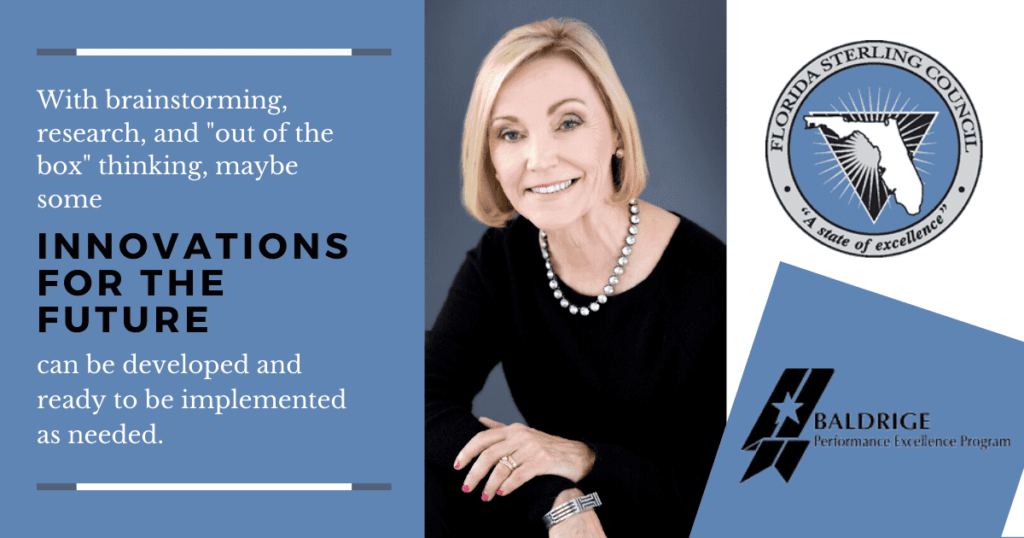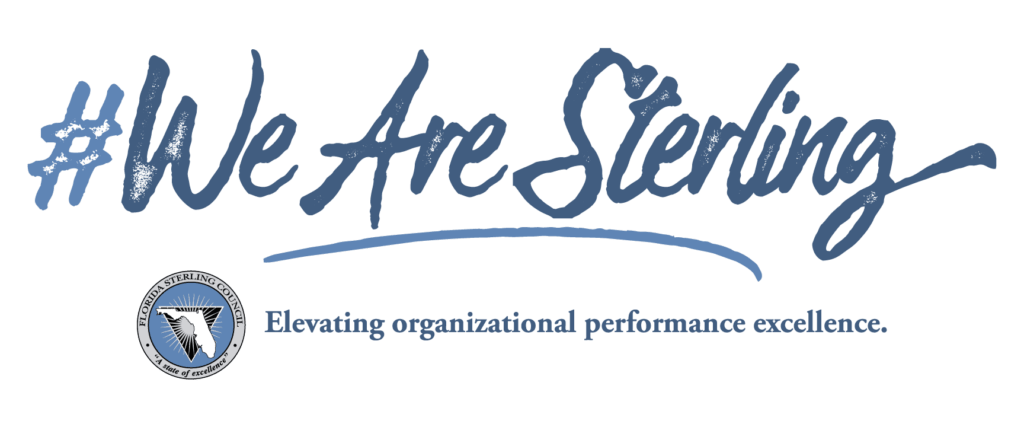
Mary Beth Corace is a Master Examiner for both the Governor’s Sterling Award and the Malcolm Baldrige National Quality Award having also served as a judge for the award. She coordinates strategic planning summits and presentations for the annual Florida Sterling Conference. Dr. Corace consults with organizations on strategic planning, continuous improvement, project management, and visual training designs and is an adjunct professor in the Department of Teaching and Learning at the University of South Florida. With over 30 years of educational experience, she has served as Pinellas Schools’ Director of Strategic Planning and Policy, administrator of the IB Program, Director of the Quality Academy, teacher at elementary, middle, high, and university levels, and writer/manager of large federal grants. Dr. Corace earned a BS degree from The Pennsylvania State University and MAE and Ph.D. degrees in Curriculum and Supervision from the University of South Florida.
You have served with us as an Examiner for sixteen years. What sticks out the most to you as the most helpful revision to the Criteria; moreover, what has been the most helpful revision or addition to Sterling as an organization?
The most helpful revision to the criteria was not a revision but actually an addition, the inclusion of the core values. I know I am dating my service as an examiner, but I remember when core values were not a part of the criteria. The inclusion of the core values supports the culture of an organization asking its leaders and workforce what are the principles and behaviors that guide their work and their decisions. These values add depth to the criteria and meaning to the actions people take on their journey to better performance.
I believe that Sterling’s offerings of self-assessments at various levels are the most helpful addition and that these additions are extremely helpful for organizations. These different levels of assessments allow an organization to choose the appropriate method to determine where it currently lands on its journey towards higher performance. Additionally, it prevents an organization from embarking on an assessment beyond its capacity.
Not only are you a Master Examiner for both Sterling and Baldrige, but you have served as a Baldrige Judge as well. How does that added perspective help you navigate site visit season? In what ways has the perspective challenged you (if it has)?
Serving as a Baldrige judge for three years provided the perspective of the additional “customer” in the link of feedback to the applicant. Understanding that examiners strive to develop feedback that is meaningful and actionable to the applicant, the feedback has to “stand on its own” for the judges, who may not fully know the applicant. It also supports the applicant in having feedback statements that stand alone without having to refer back to the application of the criteria.
It is not easy to complete two waves of the examination process, one for Sterling and one for Baldrige. This includes completing the case study, training, real application, consensus, and site visit. The logistics, however, are easier to manage as Baldrige is basically April to October, and Sterling is November to March – never a dull moment or lack of problem-solving in matching the criteria to the application (so I do not have time for puzzles). A convenience is that Sterling uses the previous year’s Baldrige Case Study so I only have to complete one case study a year.
Your dissertation, written in 2000, was called The Importance and Application of the Malcolm Baldrige Criteria in Classrooms and its Association with Student Outcomes. How were students engaged in their own learning outcomes?
I have several videos of students in classrooms at all levels sharing how they learn within that classroom set by their teacher/leader according to the Baldrige Criteria. These videos are inspirational in that students are so proud to share their learning system including goals, methods used to learn, data booklets showing progress or needed areas of work, work stations, and collaborative groups. Looking back on those findings, I find the outcomes are as true then as they are now. Classrooms with an agreed vision, mission, and culture of core values and the criteria as a framework for work produced higher levels of attendance, higher reading levels, and lower levels of disciplinary infractions. Additionally, the comments from both elementary and secondary teachers strongly support the use of the criteria in the classroom both in belief and application.
On May 28, you and Dr. Raina Knox are facilitating a virtual four-part Strategic Planning Reboot Series. As you plan the series, what have you learned from your collaboration with Raina, and what is the #1 thing you both hope participants take away from the series as a whole?
I have worked with Raina before on Sterling’s Strategic Planning Summit offered as part of the annual conference. Raina shares such interesting experiences from her work with financial institutions and other sector clients. Raina and I have served as both Sterling and Baldrige examiners and as such, we both share a passion for the criteria because it supports higher levels of performance, customer satisfaction, and employee engagement.
I know we both want participants to finish the series with an understanding, appreciation, and application of each step in the process of strategic planning and a draft of their rebooted plan. In authentic strategic planning, the first two steps of the process may have been glossed over by planners. However, now with this pandemic and the major upheaval for all types of organizations, assessing your current status with environmental scans, authentic SWOT analysis, and checking to see if your vision, mission, and values are viable are so very, very important. For example, think about the changes that have turned breweries into hand sanitizer producers and traditional schools into virtual schools. Has their work or their business model changed? Has the mission changed, short term? So, all steps, including those that have been glossed over or ignored, are so important in this series.
When did you know you wanted to become an expert on educational policy and planning? At the dawn of your research into strategic planning, how did you see the need for improvement on a macro level, and how has that view evolved over time?
I never set out to be an expert on policy and planning. I started out as an art teacher in the Panama Canal Zone traveling to multiple schools with various demographics and interests. I was challenged to set up lessons that were efficient, effective, and satisfying to both the learner and the classroom teacher. I considered the level of the student, the layout of the classroom, the curriculum requirement, the time needed including hands-on work, and clean up by all. I did not know it at the time, but I was following portions of the Baldrige/Sterling framework.
Fast forward through Pennsylvania and on to Florida, I became involved with Pinellas County Schools Quality Academy and was part of an inaugural quality staff at Carwise Middle School. This school was founded on Deming’s 14 points and the Baldrige/Sterling framework. Our collaborative teams worked with our principal and the district to move the entire school applying the business framework to education and using the framework in our classrooms. Our district had won the Sterling award in 1993 and our school applied in 1996. It was a great time to be involved in infusing quality concepts and the criteria into the district, schools, and classrooms.
I worked in the summer months in the Quality Academy applying my visual arts experience into more easily displaying the concepts of the criteria into graphics and images. We developed the linkages model that was the visual image of how the seven Baldrige/Sterling categories integrated into an entire system for performance. In order to transfer the content into visuals, I had to study and analyze the criteria for understanding and practical application. Of course, Leadership and Strategic Planning are two of the seven criteria that I had to truly understand and practice.
Learning and applying all of the criteria developed a mindset for my work for any position that I accepted and any work that I performed. The understanding of the criteria, requiring constant study and use, provided me with the knowledge and skills to support any position that my career has offered.
Where do you see the future of educational policy – both with the advent of virtual school technology and after a global experience like the COVID19 crisis (which has had a profound impact on the way, inter alia, students learn and educators teach)?
Interesting question and one that I have pondered for what we know, what we don’t know, and what we don’t know we don’t know. Our current situation demands great strategic planning in order to answer these three questions. I do know that we will never be the same and I hope we never forget to have prepared the virtual plan for our workforce just in case brick and mortar work sites have to close. I continuously ask myself, why didn’t we have a virtual plan ready to implement on day one that had been prepared and practiced? We may have somewhat prepared but just not deployment-ready all the way through an organization. I don’t know if schools or worksites will return to a five-day week. Will some good practices surface for virtual work? Will virtual learning and meetings via ZOOM or other programs continue to be offered? I don’t know what I don’t know but with brainstorming, research, and “out of the box” thinking, maybe some innovations for the future can be developed and ready to be implemented as needed.
You have twelve grandchildren (wow!). What is some general advice you have for someone expecting their first grandchild?
It is my blessing and honor to be a grandparent from a 2020 high school graduate to an 11-month baby with 10 more at various stages in between. I know there are wonderful articles and advice columns that future grandparents can access to gain insight on how to be a grandparent. What works for me is loving and listening to my children, my grandchildren, and their families. They are my priority. I try to put my opinions aside and listen for cues on what needs or wants they may have and try to fulfill them. Sometimes it is babysitting, overnight sleepovers, family vacations, carpool runs, food delivery, delivering gifts, attending school events, or quiet times spent listening or playing (catching fireflies in PA or going to the beach in FL). So, I would say, just listen, learn, and do what you can to support your grandchild. They grow so quickly but they will remember and learn from the kindness that you shared as a loving grandparent. Congratulations!
###

Would you like to see daily content like this? Follow our Facebook, LinkedIn, Instagram, and Twitter pages for an “inside look” into Examiners and the Examination process, upcoming learning and development opportunities, and more!
